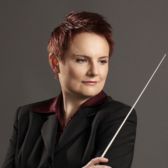5 February 2025
On Matthew Hindson’s Dangerous Creatures
 Image: Carolyn Watson
Image: Carolyn Watson Family and education-themed concerts are an integral component of programming by symphony orchestras worldwide. There is no set programming prescription for an education concert, though the general formula is a collection of short pieces, excerpts and/or movements united by a common theme. A significant number of composers, among them J.S. Bach, Bartók, Britten, Hindemith, Holst, Kodály, Ravel and Vivaldi wrote well-known works for young audiences and/or musicians.
Among the best-known works for children is Saint-Saëns' Carnival of the Animals, a light-hearted collection of depictions in fourteen movements. The composer was worried it would damage his reputation as a serious composer and so he forbade it to be performed during his lifetime. It was published the year following his passing to great enthusiasm in 1922, and remains popular today. Not long after, Russian composer Sergei Prokofiev was commissioned to write a 'symphony for children' with the result the work we know as Peter and the Wolf, which premiered in Moscow in 1936.
In a similar ilk is Matthew Hindson's Dangerous Creatures, a work commissioned by the London Philharmonic Orchestra and premiered in 2009. It makes a wonderful companion piece to the works by Saint-Saëns and/or Prokofiev and since its inception, has proven wildly popular with Australian orchestras as a staple in education concerts, with movements having been performed on some sixty occasions, an extraordinary measure of success by any means.
A work I came to know many years back when I was the resident conductor at the Conservatorium High School in Sydney, I programmed excerpts from Dangerous Creatures as part of a Festival of Australian Music in 2012. I am now charged with preparing the work in its entirety, for the US premiere next month with Indiana's La Porte County Symphony Orchestra, a regional ensemble I lead. I love presenting new works, or in this case, a work which will be new to our audience. I also particularly enjoy conducting pieces by living composers as I appreciate the luxury of being able to email them with any questions regarding the score - if only we could do the same with say, Louise Farrenc or Stravinsky!
Hindson's work, like Saint-Saëns' by which it is inspired, is a collection of movements making up a suite. They are as follows:
1. Big Black Bear
2. Spiders
3. Jellyfish
4. Army Ants
5. Rhinoceros Tango
6. Scorpions
7. Humans
The composer explains, "This piece was conceived as a contemporary Carnival of the Animals, except filled with animals that can hurt or harm us. The animals range from the enormous (Big Black Bears) to the tiny (Spiders, Army Ants, Scorpions). Each movement depicts the animals in question, and some of the movements depict pictorial interactions between humans and the animals in question: for example, waking at night to find a scorpion in one's tent. And speaking of humans, the work concludes with the most dangerous creature of all."
I am particularly excited about bringing the work to an American audience as I am often asked in jest when someone learns I come from Australia, "Does everything really try to kill you there?" My response is generally along the lines of "no, not everything", however Matthew Hindson's Dangerous Creatures is certainly not going to help me set the record straight as it were!
La Porte County Symphony Orchestra performs Hindson's Dangerous Creatures on 8 February 2025 as part of Animal Kingdom.
© Australian Music Centre (2025) — Permission must be obtained from the AMC if you wish to reproduce this article either online or in print.
Subjects discussed by this article:
Australian conductor Carolyn Watson has conducted world premieres by composers including Alan Hankers, Laura Karpman, Thomas Meadowcroft, Kjell Roikjer, Sarah Kirkland-Snider and Mike Thurber, along with the US premieres of works by Australian composers Katia Beaugeais, Elena Kats-Chernin, Matthew Hindson and John Peterson. She is Music Director of the La Porte County Symphony, Principal Guest Conductor of the Kansas City Chamber Orchestra, and Director of Orchestras at the University of Illinois. www.carolyn-watson.com
Comments
Be the first to share add your thoughts and opinions in response to this article.
You must login to post a comment.